Apps
Auto Added by WPeMatico
Auto Added by WPeMatico
If I watch a Story cross-posted from Instagram to Facebook on either of the apps, it should appear as “watched” at the back of the Stories row on the other app. Why waste my time showing me Stories I already saw?
It’s been over two years since Instagram Stories launched cross-posting to Stories. Countless hours of each feature’s 500 million daily users have been squandered viewing repeats. Facebook and Messenger already synchronized the watched/unwatched state of Stories. It’s long past time that this was expanded to encompass Instagram.
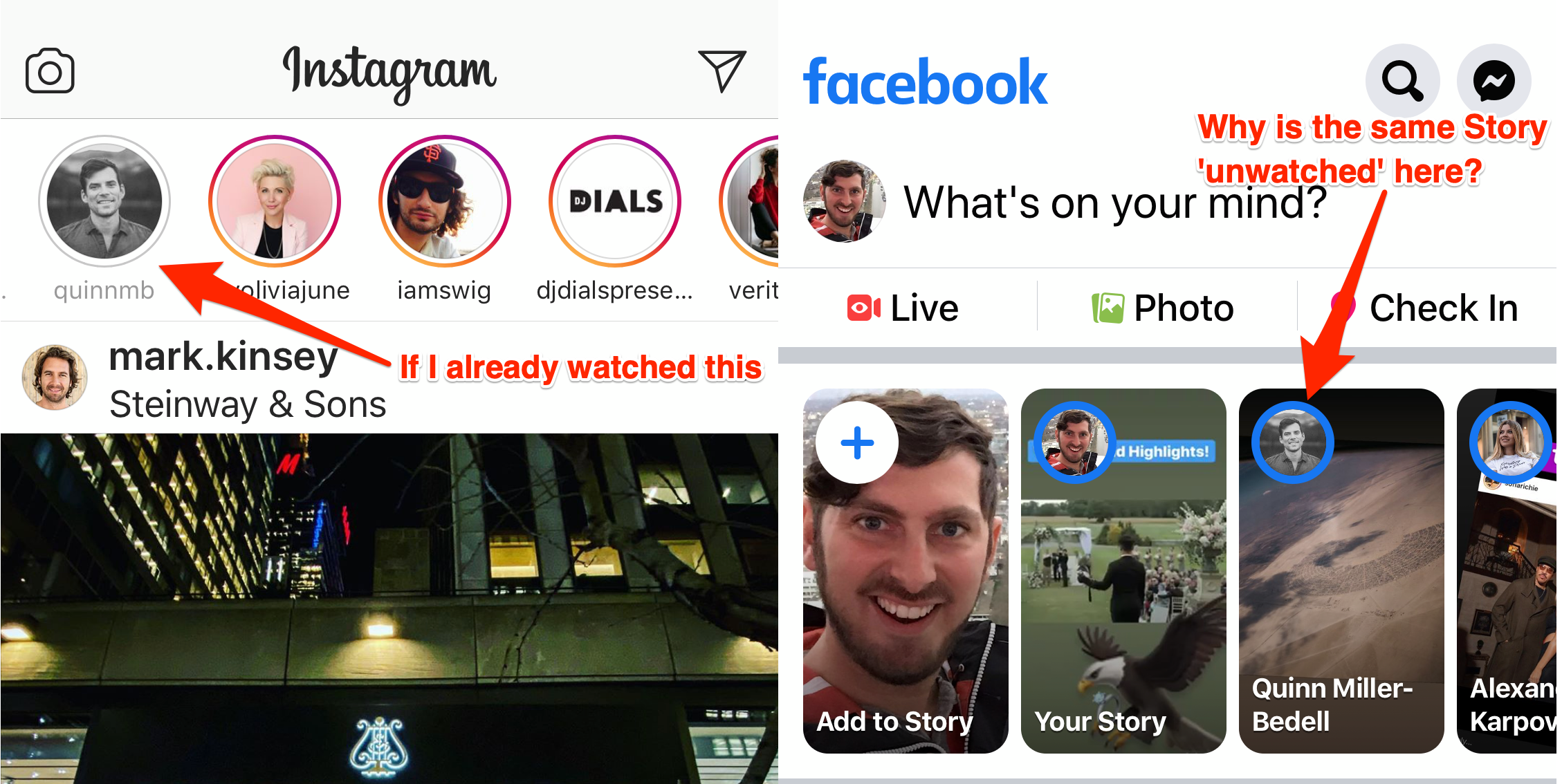
I asked Facebook and Instagram if it had plans for this. A company spokesperson told me that it built cross-posting to make sharing easier to people’s different audiences on Facebook and Instagram, and it’s continuing to explore ways to simplify and improve Stories. But they gave no indication that Facebook realizes how annoying this is or that a solution is in the works.
The end result if this gets fixed? Users would spend more time watching new content, more creators would feel seen, and Facebook’s choice to jam Stories in all its apps would fee less redundant and invasive. If I send a reply to a Story on one app, I’m not going to send it or something different when I see the same Story on the other app a few minutes or hours later. Repeated content leads to more passive viewing and less interactive communication with friends, despite Facebook and Instagram stressing that its this zombie consumption that’s unhealthy.

The only possible downside to changing this could be fewer Stories ad impressions if secondary viewings of peoples’ best friends’ Stories keep them watching more than new content. But prioritizing making money over the user experience is again what Mark Zuckerberg has emphasized is not Facebook’s strategy.
There’s no need to belabor the point any further. Give us back our time. Stop the reruns.
Powered by WPeMatico
Disney announced today it has sold the game studio FoxNext Games Los Angeles, the makers of “MARVEL Strike Force” and other titles, as well as Cold Iron Studios in San Jose, to the interactive entertainment and mobile game company Scopely. The studios were acquired by Disney in 2019 as a part of its $71.3 billion deal for 21st Century Fox. Disney is not, however, divesting of Fox’s full gaming lineup. The company clarified that its separate portfolio of Fox IP-licensed game titles were not a part of this deal and will continue to be a part of Disney’s licensed games business.
Acquisition terms were not disclosed.
FoxNext Games released its first title, “MARVEL Strike Force” in March 2018 and it brought in $150 million in its first year across iOS and Android. Another FoxNext title, “Storyscape,” released in early 2019, offers choose-your-own-adventure tales taking place in the world of “The X-Files” or “Titanic.” (This one is a part of Fogbank and not included in the acquisition.)
More recently, the studio soft-launched “Avatar: Pandora Rising,” a massive real-time strategy and social game set in Pandora from the movie “Avatar.”
According to data from Sensor Tower, “MARVEL Strike Force” has been downloaded more than 26 million times to date. “Storyscape” has topped 1.7 million installs. The Avatar title isn’t broadly available, as it’s still in development. It only has 100,000 downloads at present.
FoxNext’s website also notes a game based on the movie franchise “Alien” is coming soon. (This was acquired with FoxNext’s own deal for Cold Iron Studios back in 2018.)
“We have been hugely impressed with the incredible game the team at FoxNext Games has built with MARVEL Strike Force and can’t wait to see what more we can do together,” said Tim O’Brien, chief revenue officer at Scopely, in a statement about the deal. “In addition to successfully growing our existing business, we have been bullish on further expanding our portfolio through M&A, and FoxNext Games’ player-first product approach aligns perfectly with our focus on delivering unforgettable game experiences. We are thrilled to combine forces with their world-class team and look forward to a big future together,” he added.
Scopely, which hit over a billion in lifetime revenue in summer 2019, had also acquired DIGIT Game Studios last year, home to the top-grossing MMO/strategy game “Star Trek Fleet Command” and strategy MMO “Kings of the Realm.”
Other Scopely top game titles include “Looney Tunes World of Mayhem,” “The Walking Dead: Road to Survival,” “Wheel of Fortune: Free Play,” “WWE Champions 2019,” “Yahtzee with Buddies Dice Game,” “Dice with ellen,” “Scrabble Go” and many more.
With its latest acquisition, Scopely adds another top-grossing game to its lineup, expands its in-development pipeline and gains the expertise of the FoxNext team. When the transaction completes, FoxNext Games President Aaron Loeb will join Scopely in a newly created executive role and FoxNext Games SVP & GM Amir Rahimi will lead the FoxNext Games Los Angeles studio within Scopely as president, Games.
(Correction: Typos of FoxNext’s name corrected. It is FoxNext, not FoxNet; Also added info on Storyscape being excluded from the deal.)
Powered by WPeMatico
Substack announced today that it has built support for multiple authors into its service. The company provides a publishing tool that blends blogs and email newsletters into a single entity, with a focus on subscription monetization.
The day’s updates also include a number of publisher-friendly tools, like shared access and homepage features closer to those of traditional websites than the linear timeline style that Substack has focused on so far.
The additions, which also include nice-to-haves like author pages for multi-person publications, mark a new level of maturity for Substack, a service that quickly attracted both authors and an audience after it launched. That early traction helped the company land an outsized — when compared to the size of its team — Series A that put $15.6 million into the business.
For users of the service, news of the funding was welcome. As was Substack’s disclosure at the time that the publications on its platform had attracted 50,000 paying subscribers. That figure was exciting, indicating that the company’s product might help writers of all sorts build a monetized audience, a holy grail for written creatives.
In light of today’s updates, TechCrunch asked Substack about the progress of its monetization, specifically curious about how many paid subscribers Substack publications had accreted. The company declined to share new numbers, with its co-founder and COO Hamish McKenzie instead saying that his team is “very happy with the growth [it has] seen over the past few months.”
In a company blog post accompanying today’s news, the firm noted “tens of thousands of paying subscribers,” implying that Substack has not yet doubled its former 50,000 person subscriber base. (Doing so would give Substack six-figures worth of subscribers. However, as it reached the 50,000 paid subscriber mark less than a year ago, it might be aggressive to expect such a rapid doubling.)
Part of Substack’s initial success came from its intelligent blending of blogs and newsletters. Anyone who wanted to build one or the other got both, in a format that worked for each; bloggers could send email, and the email-focused also got a home on the internet. That the product came stapled to monetization tools made it all the more attractive.
Today’s updates help add a new form to the Substack mix: Websites. Here’s what a new Substack website can look like:
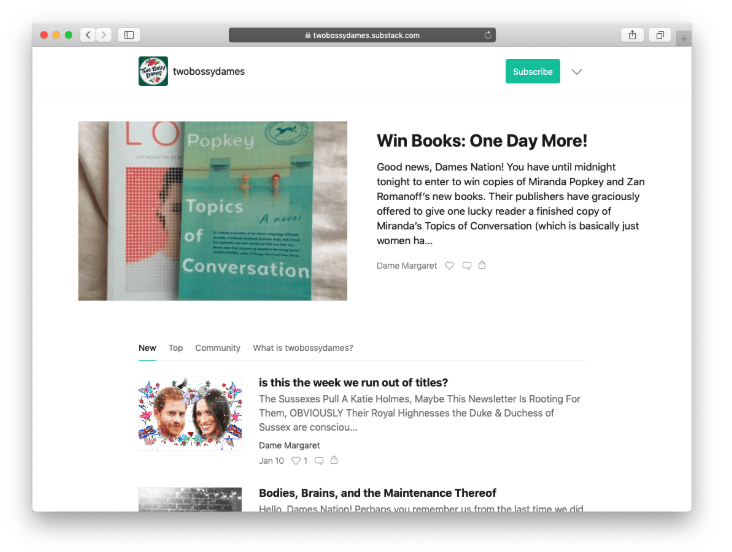
The ability to pin posts to the top of publications, the addition of photo bylines, and other tools mean that users can now do much more with the Substack publications. The company will now have to tread the line between the power of simplicity, and simply empowering its power users.
The company’s model appears to be working. Traffic to the larger Substack service has risen in recent months, according to analytics service Alexa. Substack was ranked among the 13,000th most visited global site in October of last year, according to the platform. It’s now in the 11,000s. With media companies like The Dispatch hatching on Substack, and with today’s updates, expect that number to continue to fall.
Substack is a bet that readers will pay for the written work that they care about. It’s a good wager. And better tools will tilt the odds more in its favor.
Now we can simply count down until Substack announces 100,000 paid subscribers.
Powered by WPeMatico
Octi has created a new social network that uses augmented reality to connect the act of seeing your friends in real life with viewing digital content, like their favorite YouTube videos and Spotify songs.
When I wrote about the startup in 2018, it was building AR technology that could do a better job of recognizing the human body and movement. Last week, co-founder and CEO Justin Fuisz (pictured above) told me that this was “a really cool feature,” but that Octi’s investors pushed him “to do more, go deeper.”
Speaking of those investors, the startup says it has now raised $12 million in funding (including a previously announced seed round of $7.5 million) from Live Nation, Anheuser-Busch InBev, Peter Diamandis’ Bold Capital Partners, Human Ventures, I2BF, Day One Ventures, Tom Conrad, Scott Belsky and Josh Kushner.
Last week, Fuisz demonstrated what he now sees as Octi’s “mic drop” moment — opening the new app and pointing his iPhone camera at a colleague. The app quickly recognized her, allowing Fuisz to send her a friend request. And once the request was accepted, Fuisz could look at her through the camera again, where she was surrounded by a floating “belt” of virtual items that she’d created with videos, songs and photos.

Octi also allows you to include fun effects and stickers. Your friends can change your profile too, making you wear a funny hat or giving you a rousing theme song for the day.
To create a facial recognition experience that’s fast and simple, Fuisz said that Octi’s powered by a “neural network on the edge,” allowing the app to process images on the device (rather than uploading them to the cloud) in a privacy-friendly way.
He said the company has taken other steps to optimize the process, like prioritizing friends-of-friends rather than searching through the faces of everyone in the network, resulting in an app that can identify a friend in as little as 20 milliseconds.
While Octi allows you to view friends’ profiles remotely, it’s worth emphasizing that the core experience is meant to be in-person. In fact, the company provided a statement from analyst Rich Greenfield in which he described the app as “an impressive technology that gives teens a compelling reason to be present and communicate with their phones, while gathered with their closest friends.”

I wondered whether a new social dynamic also provides new opportunities for harassment and bullying, but Fuisz noted that for now, Octi profiles and belts are only visible to friends that you’ve approved. So if one of your connections is doing something you don’t like, “You just say goodbye. That’s it. That’s a simple way of dealing with it.”
Fuisz added that this initial version provides a foundation for many more experiences: “There’s endless opportunity for games and other fun things you can do.”
Ultimately, he’s hoping to turn this into a WeChat-style platform for outside developers to build social tools and content. And because Octi works on iPhone 7 and above (with plans for an Android version later this year), it can potentially reach an enormous audience out of the gate, rather than facing the scale issues of a more specialized AR or VR hardware platform.
Powered by WPeMatico
Tencent, one of the world’s biggest video and online gaming companies by revenue, today made another move to help cement that position. The Chinese firm has made an offer to fully acquire Funcom, the games developer behind Conan Exiles (and others in the Conan franchise), Dune and some 28 other titles. The deal, when approved, would value the Oslo-based company at $148 million (NOK 1.33 billion) and give the company a much-needed cash injection to follow through on its longer-term strategy around its next generation of games.
Funcom is traded publicly on the Oslo Stock Exchange, and the board has already recommended the offer, which is being made at NOK 17 per share, or around 27% higher than its closing share price the day before (Tuesday).
The news is being made with some interesting timing. Today, Tencent competes against the likes of Sony, Microsoft and Nintendo in terms of mass-market, gaming revenues. But just earlier this week, it was reported that ByteDance — the publisher behind breakout social media app TikTok — was readying its own foray into the world of gaming.
If it goes ahead, that would set up another level of rivalry between the two companies. Tencent also has a massive interest in the social media space, specifically by way of its messaging app WeChat . While many consumers will have multiple apps, when it comes down to it, spending money in one represents a constraint on spending money in another. ByteDance currently profits from having content on its social apps related to Tencent gameplay, so building its own content could be one way of moving away from that. The two have (naturally) also been battling it out in court in China over unfair competition claims, in part related to that gaming content.
Today, Tencent is one of the world’s biggest video game companies: in its last reported quarter (Q3 in November), Tencent said that it make RMB28.6 billion ($4.1 billion) in online gaming revenue, with smartphone games accounting for RMB24.3 billion of that.
Acquisitions and controlling stakes form a key part of the company’s growth strategy in gaming. Among its very biggest deals, Tencent paid $8.6 billion for a majority stake in Finland’s Supercell back in 2016. It also has a range of controlling stakes in Riot Games, Epic, Ubisoft, Paradox, Frontier and Miniclip. These companies, in turn, also are making deals: just earlier this month it was reported (and sources have also told us) that Miniclip acquired Israel’s Ilyon Games (of Bubble Shooter fame) for $100 million.
Turning back to Funcom, Tencent was already an investor in the company: it took a 29% stake in it in September 2019 in a secondary deal, buying out KGJ Capital (which had previously been the biggest shareholder).
“Tencent has a reputation for being a responsible long-term investor, and for its renowned operational capabilities in online games,” said Funcom CEO Rui Casais at the time. “The insight, experience, and knowledge that Tencent will bring is of great value to us and we look forward to working closely with them as we continue to develop great games and build a successful future for Funcom.”
In retrospect, this was laying the groundwork and relationships for a bigger deal just months down the line.
“We have a great relationship with Tencent as our largest shareholder and we are very excited to be part of the Tencent team,” Casais said in a statement today. “We will continue to develop great games that people all over the world will play, and believe that the support of Tencent will take Funcom to the next level. Tencent will provide Funcom with operational leverage and insights from its vast knowledge as the leading company in the game space.”
The rationale for Funcom is that the company had already determined that it needed further investment in order to follow through on its longer-term strategy.
According to a statement issued before it recommended the offer, the company is continuing to build out the “Open World Survival segment” using the Games-as-a-Service business model (where you pay to fuel up with more credits); and is building an ambitious Dune project set to launch in two years.
“Such increased focus would require a redirection of resources from other initiatives, the most significant being the co-op shooter game, initially scheduled for release during 2020 that has been impacted by scope changes due to external/market pressures with increasingly strong competition and internal delays,” the board writes, and if it goes ahead with its strategy, “It is likely that the Company will need additional financing to supplement the revenue generated from current operations.”
Powered by WPeMatico
Losing access to Google software and services understandably threw Huawei for a loop. The Chinese hardware giant has clearly been working on a contingency plan to deal with the loss of access to things like Android and the Play Store, but Google’s offering formed so much of the devices’ software core — as they do so many of its competitors.
Huawei just lined up a pretty big name in its attempts to rebuild a competitive software suite. Dutch mapping giant TomTom has agreed to provide access to its navigation, mapping and traffic information. The two companies finalized a deal this week, per Reuters, letting Huawei use that information to build its own proprietary apps.
TomTom confirmed the deal, but declined to offer additional information. The move comes as the mapping company has taken a step back from hardware offerings in favor of monetizing its software services. Given Huawei’s pretty massive footprint in the global smartphone market, this presents a pretty big deal for TomTom, which had previously provided info for AppleMaps.
Huawei was left reeling from U.S. sanctions that cut off access to U.S.-produced software and components. The company has been working to build its own Android competitor behind the scenes, though what we’ve seen of HarmonyOS has thus far been fairly muted. Rumors have also swirled around Huawei developing its own Maps competitor, so it’s hard to say how much it views this new deal as a stopgap.
Powered by WPeMatico
Facebook spying on teens, Twitter accounts hijacked by terrorists, and sexual abuse imagery found on Bing and Giphy were amongst the ugly truths revealed by TechCrunch’s investigating reporting in 2019. The tech industry needs more watchdogs than ever as its size enlargens the impact of safety failures and the abuse of power. Whether through malice, naivety, or greed, there was plenty of wrongdoing to sniff out.
Led by our security expert Zack Whittaker, TechCrunch undertook more long-form investigations this year to tackle these growing issues. Our coverage of fundraises, product launches, and glamorous exits only tell half the story. As perhaps the biggest and longest running news outlet dedicated to startups (and the giants they become), we’re responsible for keeping these companies honest and pushing for a more ethical and transparent approach to technology.
If you have a tip potentially worthy of an investigation, contact TechCrunch at tips@techcrunch.com or by using our anonymous tip line’s form.

Image: Bryce Durbin/TechCrunch
Here are our top 10 investigations from 2019, and their impact:
Josh Constine’s landmark investigation discovered that Facebook was paying teens and adults $20 in gift cards per month to install a VPN that sent Facebook all their sensitive mobile data for market research purposes. The laundry list of problems with Facebook Research included not informing 187,000 users the data would go to Facebook until they signed up for “Project Atlas”, not receiving proper parental consent for over 4300 minors, and threatening legal action if a user spoke publicly about the program. The program also abused Apple’s enterprise certificate program designed only for distribution of employee-only apps within companies to avoid the App Store review process.
The fallout was enormous. Lawmakers wrote angry letters to Facebook. TechCrunch soon discovered a similar market research program from Google called Screenwise Meter that the company promptly shut down. Apple punished both Google and Facebook by shutting down all their employee-only apps for a day, causing office disruptions since Facebookers couldn’t access their shuttle schedule or lunch menu. Facebook tried to claim the program was above board, but finally succumbed to the backlash and shut down Facebook Research and all paid data collection programs for users under 18. Most importantly, the investigation led Facebook to shut down its Onavo app, which offered a VPN but in reality sucked in tons of mobile usage data to figure out which competitors to copy. Onavo helped Facebook realize it should acquire messaging rival WhatsApp for $19 billion, and it’s now at the center of anti-trust investigations into the company. TechCrunch’s reporting weakened Facebook’s exploitative market surveillance, pitted tech’s giants against each other, and raised the bar for transparency and ethics in data collection.
Zack Whittaker’s profile of the heroes who helped save the internet from the fast-spreading WannaCry ransomware reveals the precarious nature of cybersecurity. The gripping tale documenting Marcus Hutchins’ benevolent work establishing the WannaCry kill switch may have contributed to a judge’s decision to sentence him to just one year of supervised release instead of 10 years in prison for an unrelated charge of creating malware as a teenager.
TechCrunch contributor Mark Harris’ investigation discovered inadequate emergency exits and more problems with Elon Musk’s plan for his Boring Company to build a Washington D.C.-to-Baltimore tunnel. Consulting fire safety and tunnel engineering experts, Harris build a strong case for why state and local governments should be suspicious of technology disrupters cutting corners in public infrastructure.
Josh Constine’s investigation exposed how Bing’s image search results both showed child sexual abuse imagery, but also suggested search terms to innocent users that would surface this illegal material. A tip led Constine to commission a report by anti-abuse startup AntiToxin (now L1ght), forcing Microsoft to commit to UK regulators that it would make significant changes to stop this from happening. However, a follow-up investigation by the New York Times citing TechCrunch’s report revealed Bing had made little progress.
Zack Whittaker’s investigation surfaced contradictory evidence in a case of alleged grade tampering by Tufts student Tiffany Filler who was questionably expelled. The article casts significant doubt on the accusations, and that could help the student get a fair shot at future academic or professional endeavors.
Natasha Lomas’ chronicle of troubles at educational computer hardware startup pi-top, including a device malfunction that injured a U.S. student. An internal email revealed the student had suffered a “a very nasty finger burn” from a pi-top 3 laptop designed to be disassembled. Reliability issues swelled and layoffs ensued. The report highlights how startups operating in the physical world, especially around sensitive populations like students, must make safety a top priority.
Sarah Perez and Zack Whittaker teamed up with child protection startup L1ght to expose Giphy’s negligence in blocking sexual abuse imagery. The report revealed how criminals used the site to share illegal imagery, which was then accidentally indexed by search engines. TechCrunch’s investigation demonstrated that it’s not just public tech giants who need to be more vigilant about their content.
Megan Rose Dickey explored a botched case of discrimination policy enforcement by Airbnb when a blind and deaf traveler’s reservation was cancelled because they have a guide dog. Airbnb tried to just “educate” the host who was accused of discrimination instead of levying any real punishment until Dickey’s reporting pushed it to suspend them for a month. The investigation reveals the lengths Airbnb goes to in order to protect its money-generating hosts, and how policy problems could mar its IPO.
Zack Whittaker discovered that Islamic State propaganda was being spread through hijacked Twitter accounts. His investigation revealed that if the email address associated with a Twitter account expired, attackers could re-register it to gain access and then receive password resets sent from Twitter. The article revealed the savvy but not necessarily sophisticated ways terrorist groups are exploiting big tech’s security shortcomings, and identified a dangerous loophole for all sites to close.
Josh Constine found dozens of pornography and real-money gambling apps had broken Apple’s rules but avoided App Store review by abusing its enterprise certificate program — many based in China. The report revealed the weak and easily defrauded requirements to receive an enterprise certificate. Seven months later, Apple revealed a spike in porn and gambling app takedown requests from China. The investigation could push Apple to tighten its enterprise certificate policies, and proved the company has plenty of its own problems to handle despite CEO Tim Cook’s frequent jabs at the policies of other tech giants.
This Game Of Thrones-worthy tale was too intriguing to leave out, even if the impact was more of a warning to all startup executives. Josh Constine’s look inside gaming startup HQ Trivia revealed a saga of employee revolt in response to its CEO’s ineptitude and inaction as the company nose-dived. Employees who organized a petition to the board to remove the CEO were fired, leading to further talent departures and stagnation. The investigation served to remind startup executives that they are responsible to their employees, who can exert power through collective action or their exodus.
If you have a tip for Josh Constine, you can reach him via encrypted Signal or text at (585)750-5674, joshc at TechCrunch dot com, or through Twitter DMs
Powered by WPeMatico
At most, 7 million of Instagram’s 1 billion-plus users have downloaded its standalone IGTV app in the 18 months since launch. And now, Instagram’s main app is removing the annoying orange IGTV button from its home page in what feels like an admission of lackluster results. For reference, TikTok received 1.15 billion downloads in the same period since IGTV launched in June 2018. In just the US, TikTok received 80.5 million downloads compared to IGTV’s 1.1 million since then, according to research commissioned by TechCrunch from Sensor Tower.
To be fair, TikTok has spent huge sums on install ads. But while long-form mobile video might gain steam as the years progress, Instagram hasn’t seemed to crack the code yet.
“As we’ve continued to work on making it easier for people to create and discover IGTV content, we’ve learned that most people are finding IGTV content through previews in Feed, the IGTV channel in Explore, creators’ profiles and the standalone app. Very few are clicking into the IGTV icon in the top right corner of the home screen in the Instagram app” a Facebook company spokesperson tells TechCrunch. “We always aim to keep Instagram as simple as possible, so we’re removing this icon based on these learnings and feedback from our community.”

Instagram users don’t need the separate IGTV app to watch longer videos, as the IGTV experience is embedded in the main app and can be accessed via in-feed teasers, a tab of the Explore page, promo stickers in Stories, and profile tabs. Still, the fact that it wasn’t an appealing enough destination to warrant a home page button shows IGTV hasn’t become a staple like past Instagram launches including video, Stories, augmented reality filters, or Close Friends.
One thing still missing is an open way for Instagram creators to earn money directly from their IGTV videos. Users can’t get an ad revenue share like with YouTube or Facebook Watch. They also can’t receive tips or sell exclusive content subscriptions like on Facebook, Twitch, or Patreon.
The only financial support Facebook and Instagram have offered IGTV creators is reimbursement for production costs for a few celebrities. Those contracts also require creators to avoid making content related to politics, social issues, or elections, according to Bloomberg‘s Lucas Shaw and Sarah Frier.
“In the last few years we’ve offset small production costs for video creators on our platforms and have put certain guidelines in place,” a Facebook spokesperson told Bloomberg. “We believe there’s a fundamental difference between allowing political and issue-based content on our platform and funding it ourselves.” That seems somewhat hypocritical given Facebook CEO Mark Zuckerberg’s criticism of Chinese app TikTok over censorship of political content.
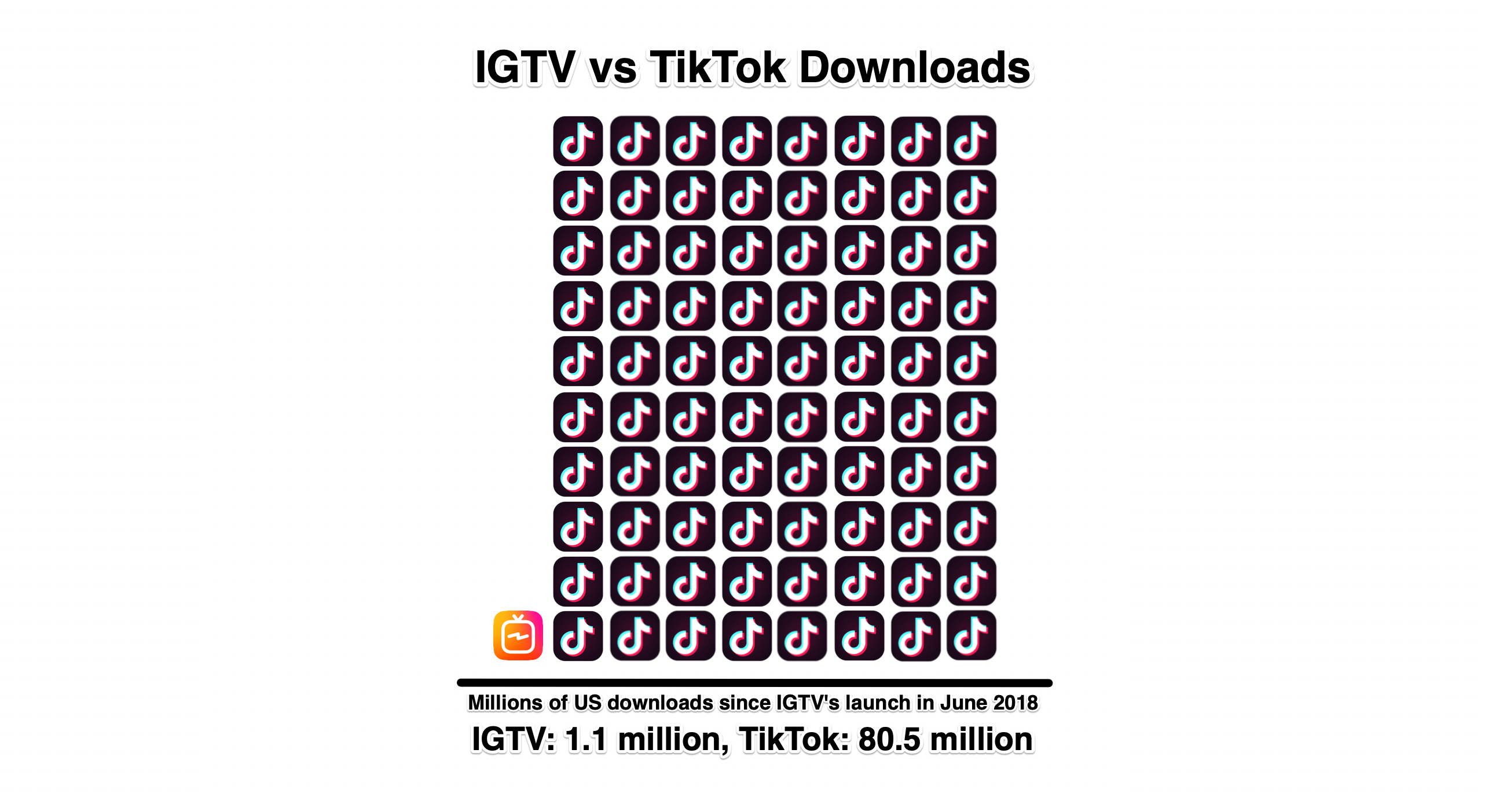
Now users need to tap the IGTV tab inside Instagram Explore to view long-form videoAnother thing absent from IGTV? Large view counts. The first 20 IGTV videos I saw today in its Popular feed all had fewer than 200,000 views. BabyAriel, a creator with nearly 10 million Instagram followers that the company touted as a top IGTV creator has only post 20 of the longer videos to date with only one receiving over 500,000 views.
When the lack of monetization is combined with less than stellar view counts compared to YouTube and TikTok, it’s understandable why some creators might be hesistant to dedicate time to IGTV. Without their content keeping the feature reliably interesting, it’s no surprise users aren’t voluntarily diving in from the home page.
In another sign that Instagram is folding IGTV deeper into its app rather than providing it more breathing room of its own, and that it’s eager for more content, you can now opt to post IGTV videos right from the main Instagram feed post video uploader. AdWeek Social Pro reported this new “long video” upload option yesterday. A Facebook company spokesperson tells me “We want to keep our video upload process as simple as possible” and that “Our goal is to create a central place for video uploads”.

IGTV launched with a zealotish devotion to long-form vertical video despite the fact that little high quality content of this nature was being produced. Landscape orientation is helpful for longer clips that often require establishing shots and fitting multiple people on screen, while vertical was better for quick selfie monologues.
Yet Instagram co-founder Kevin Systrom described IGTV to me in August 2018, declaring that “What I’m most proud of is that Instagram took a stand and tried a brand new thing that is frankly hard to pull off. Full-screen vertical video that’s mobile only. That doesn’t exist anywhere else.”
Now it doesn’t exist on Instagram at all since May 2019 when IGTV retreated from its orthodoxy and began allowing landscape content. I’d recommended it do that from the beginning, or at least offer a cropping tool for helping users turn their landscape videos into coherent vertical ones, but nothing’s been launched there either.

If Instagram still cares about IGTV, it needs to attract more must-see videos by helping creators get paid for their art. Or it needs to pour investment into buying high quality programming like Snapchat Discover’s Shows. If Instagram doesn’t care, it should divert development resources to it’s TikTok clone Reels that actually looks very well made and has a shot at stealing market share in the remixable social entertainment space.
For a company that’s won by betting big and moving fast, IGTV feels half-baked and sluggish. That might have been alright when Snapchat was shrinking and TikTok was still Musically, but Instagram is heading into an era of much stiffer competition. Quibi and more want to consume multi-minute spans of video viewing on mobile, and the space could grow as adults familiarize with the format. But offering the platform isn’t enough for Instagram. It needs to actively assist creators with finding what content works, and how to earn sustainable wages marking it.
Powered by WPeMatico
Zendesk acquired Base CRM in 2018 to give customers a CRM component to go with its core customer service software. After purchasing the company, it changed the name to Sell, and today the company announced the launch of the new Sell Marketplace.
Officially called The Zendesk Marketplace for Sell, it’s a place where companies can share components that extend the capabilities of the core Sell product. Companies like MailChimp, HubSpot and QuickBooks are available at launch.
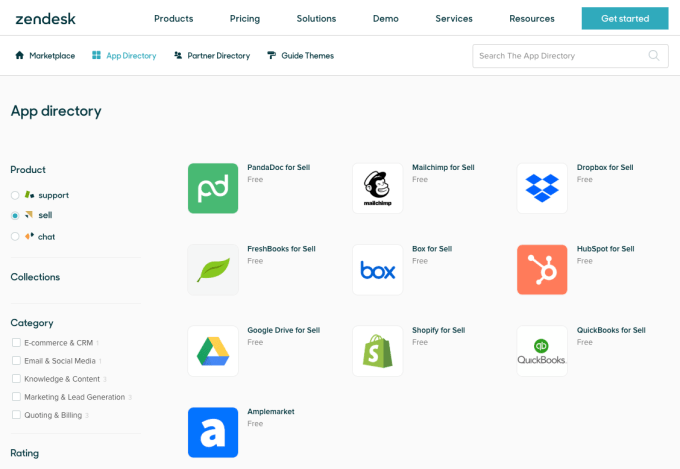
App directory in Sell Marketplace. Screenshot: Zendesk
Matt Price, SVP and general manager at Zendesk, sees the marketplace as a way to extend Sell into a platform play, something he thinks could be a “game changer.” He likened it to the impact of app stores on mobile phones.
“It’s that platform that accelerated and really suddenly [transformed smart phones] from being just a product to [launching an] industry. And that’s what the marketplace is doing now, taking Sell from being a really great sales tool to being able to handle anything that you want to throw at it because it’s extensible through apps,” Price explained.
Price says that this ability to extend the product could manifest in several ways. For starters, customers can build private apps with a new application development framework. This enables them to customize Sell for their particular environment, such as connecting to an internal system or building functionality that’s unique to them.
In addition, ISVs can build custom apps, something Price points out they have been doing for some time on the Zendesk customer support side. “Interestingly Zendesk obviously has a very large community of independent developers, hundreds of them, who are [developing apps for] our support product, and now we have another product that they can support,” he said.
Finally, industry partners can add connections to their software. For instance, by installing Dropbox for Sell, it gives sales people a way to save documents to Dropbox and associate them with a deal in Sell.
Of course, what Zendesk is doing here with Sell Marketplace isn’t new. Salesforce introduced this kind of app store concept to the CRM world in 2006 when it launched AppExchange, but the Sell Marketplace still gives Sell users a way to extend the product to meet their unique needs, and that could prove to be a powerful addition.
Powered by WPeMatico
When Intuit acquired Mint more than a decade ago, mobile was in a different place — as were tech-enabled financial services. There hasn’t been much progress for the personal finance tracker app category in the meantime. Mint has stumbled along with integration issues and tiresome data misclassifications. For many, the best alternative has been firing up a spreadsheet.
Copilot is a new personal finance-tracking app from a former Googler that seems like it could garner a following based on its slick design and ease of use. The subscription iOS app lets you load your financial data, create custom categories for transactions and set budgets. It has been invitation-only for the past several months, but is launching publicly today.
Founder Andrés Ugarte told TechCrunch that he started the effort after eight years at Google — most recently inside its Area 120 experimental products division — because of slow progress in the personal finance space since Mint’s acquisition.
“I’ve been trying to use personal finance apps for the last eight years, and I eventually ended up giving up on them,” Ugarte says. “I was willing to make them work, and create my own categories and fix the data so that stuff was all categorized correctly. But I was always disappointed because the apps never felt smart because they would make the same mistakes again.”
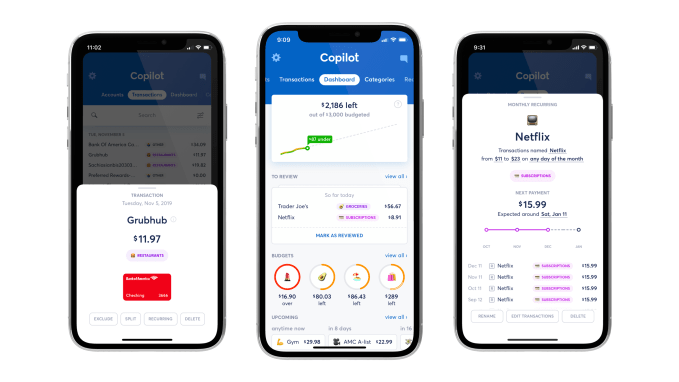
I spent a few hours poking around Copilot over the past couple of days and I like what I’ve seen. The design is friendlier than other options, but its major strengths are that you can easily re-categorize a transaction that didn’t automatically fall in the bucket that you wanted it to, mark internal transfers between accounts and exclude one-off purchases from your tracked budget. Other apps have also allowed these functionalities, but Copilot lets you denote whether you want every transaction with a particular vendor to route to a certain category or bypass your budget entirely, so it actually learns from your activity.
In some ways, the killer feature of Copilot is just how great Plaid is. The app relies heavily on the Visa-acquired financial services API startup, and I can see why the startup was so successful. The integration’s intuitiveness alongside Copilot’s already smooth on-boarding process gives users early indication for the app’s thoughtful design.
Copilot has its limitations, mainly in that the team is just two people right now, so those holding out for desktop or Android support might have to wait a bit. Some may be turned off by the app’s $2.99 monthly subscription price, though there are more than a few reasons to avoid free apps that have access to all of your financial info. Copilot maintains that users’ financial info will never be sold to or shared with third parties.
Ugarte has largely been self-funding the effort by selling off his Google shares, but the team just locked down a $250,000 angel round and is searching for more funding.
Powered by WPeMatico